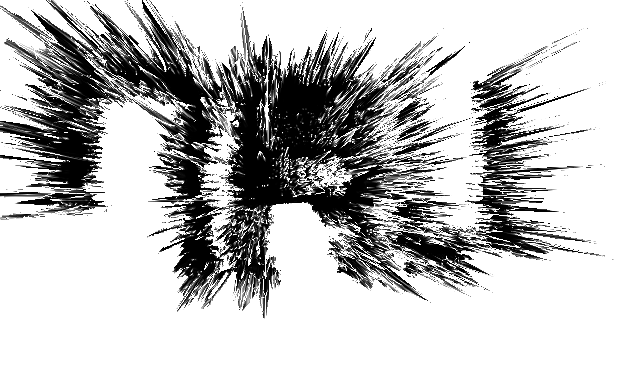
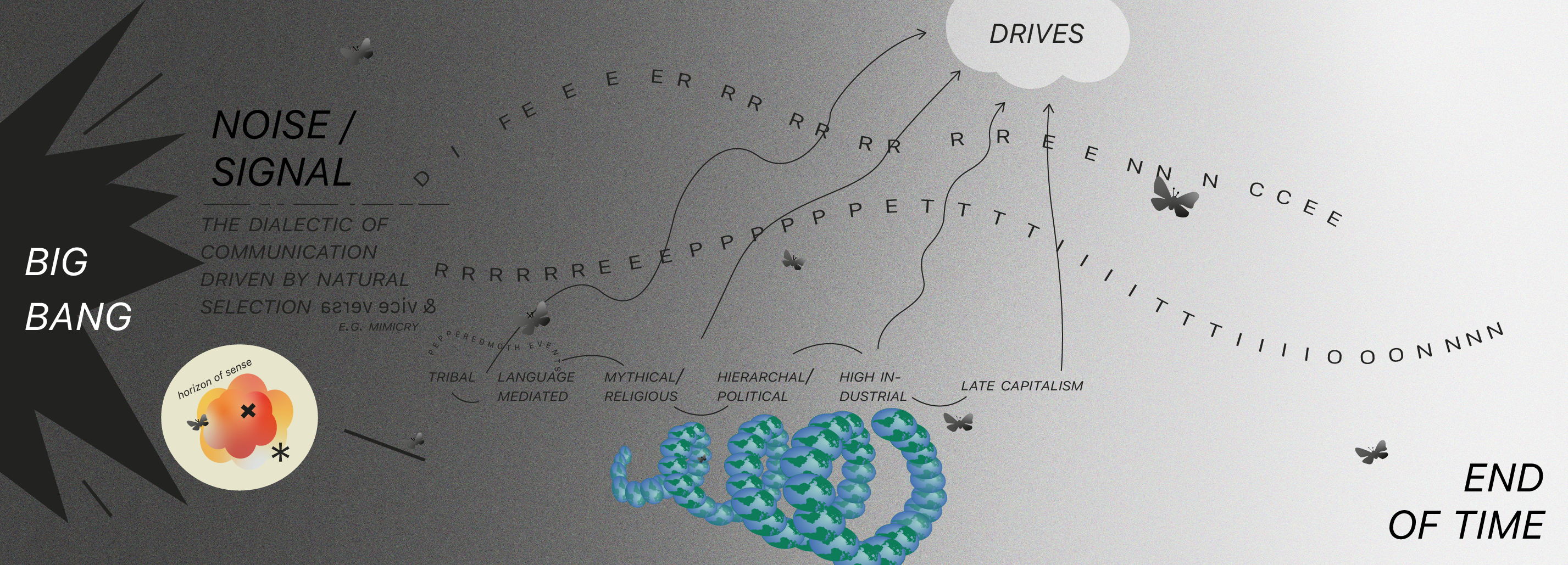
This diagram imagines the alleged history and projected future of the observable universe from the perspective of what we consider to be significant noise-events (i.e. paradigm-shifts) with regard to cosmology. Cosmology in its most general sense of entropy: a panoramic perspective on beginnings and ends. It starts off from the assumption of the Big Bang: the progressive differentiation of matter leading to the formation of celestial bodies, and eventually the emergence of life. Life is shown here to undergo the process that we observed in the Landscape of affordances diagram. We take the Peppered moth (Biston betularia) as an example of what we term “the dialectic of natural selection driven by communication and vice versa,” which can be understood in terms of the process the moth species underwent due to significant environmental changes. Biston betularia betularia morpha typica, the “original” Peppered moth, transformed its chequered/peppered pattern from black and white to prominently black, receiving the new designation of Biston betularia betularia morpha carbonaria. The reference to carbon is due to the fact that the Peppered moth changed its colour because of the increasingly darkened surfaces it was surrounded by: the pervasive burning of coal during the industrial revolution caused the peppered-like surfaces the moth used to camouflage against to become blackened with soot. The moth was thereby exposed to higher levels of predation, and only darker moths tended to survive. The peppered-moth symbol repeats to signify peppered-moth-like events which continue to register across our cosmological perspective. Another example of this, not pictured in the diagram, could be the discovery of Cosmic Microwave Background Radiation (considered to be the observation that currently supports the Big Bang theory). When first “discovered”, the CMBR radio signal was assumed to represent irrelevant interference, perhaps due to apparatus malfunction (or even pigeon poop). Eventually, the scientists making the observations realised they were picking up microwaves, the resounding remnants of the origins of the universe. What is significant to signal in this diagram, and this is how it relates to the Affordances and the Geophilosophy ones, is that noise and signal are in constant transformation, and this is precisely how they evolve (within the framework/from the perspective of agents that can observe these patterned changes). An agent is ‘in conversation’ with its environment, until its environment changes, and the agent adjusts to be able to ‘converse’ again. Anything from mimicry to the discovery of the cosmic background radiation (originally interpreted as ‘background noise’) is relevant to the interpretation of the changing cosmological environment. Difference and repetition are presented prominently in the context of changing ‘conversational’ drives, as two basic qualities agents have access to as observables for the understanding/interpretation of signal and noise in the context of evolving matter in the universe.
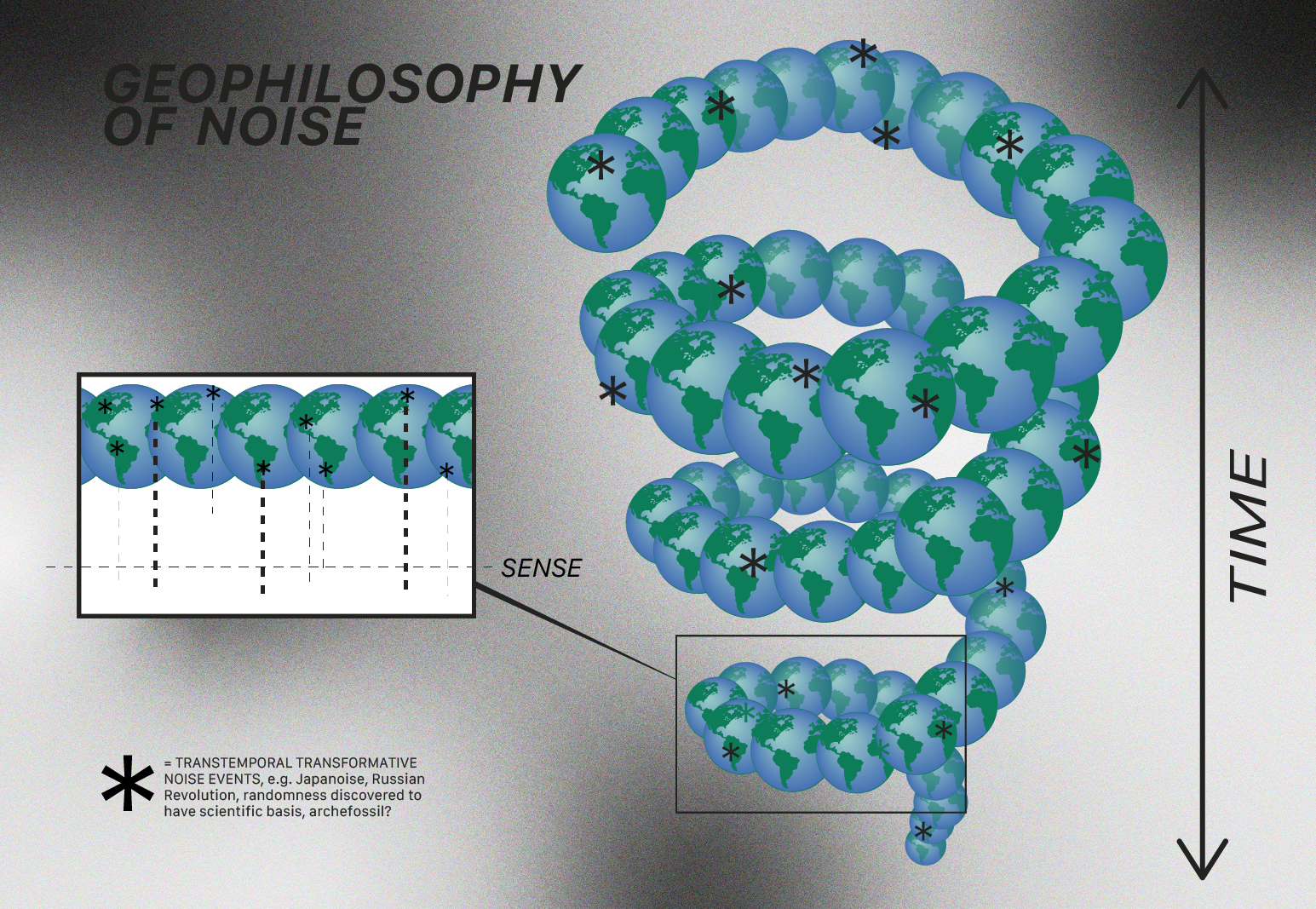
The geophilosophy of noise diagram represents the possibility of noises (understood as disruption, novelty, divergence/diversity, alterity, otherness, etc.) to be perceived when crossing the threshold of sense. Geophilosophy is a term taken from Deleuze and Guattari which we employ here to represent the bridging between the geological and cultural history of the Earth, drawing attention to the interrelated spatiotemporal situatedness of thought and events. The aim of the concept is to question the disciplinary boundaries between areas like geology, philosophy, and sociology. Sense is here understood rationally (making sense) and sensually (in relation to sensual perception). Occurrences in different parts of the globe might emit their “signal” in a feeble way, meaning that they might not be perceived outside of their localities; might not enter a wider discourse; be acknowledged, etc. However, they can increase their power and volume in iterating themselves through time (persistence), or overlapping with their appearance (detection, perception) in other parts of the globe as “received messages” or as terms of comparison. When this overlapping occurs, the signal of this kind of noise becomes strong enough to cross the threshold of sense, and become perceived. An example is Japanoise: noise practices were developed within the borders of Japan in different scenes, local, isolated between themselves, reliant on communities gathering around specific “kissa” or independent music stores. Japanoise was not a global phenomenon up until it reached popularity (through mail art, exchanges of merch via post, etc) in the West. When the threshold of sense was crossed, all of a sudden noise assumed an entirely different meaning and shape, especially when compared to industrial music and experiences of local communities/collectivities/DIY production and distribution in the West. Of course, this came with a big baggage of “exotic radicalism” and consequent fetishisazion of extreme noise practices. Eventually this led to the co-optation of noise in mainstream culture. When asked about the noise scene in Japan, Japanese “noisicians” do not recognize or acknowledge the presence of an actual “national” scene, and the very notion of “Japanoise” as a coherent phenomenon has been constructed by the Western gaze discovering this novel and radical way of making noise. Another example is represented by the different “signal-emitting” events leading up to movements such as the Deaf rights movement. In this case, isolated events concerning the treatment of D/deaf individuals and communities, the acknowledgment of Sign Languages, and levels of equitable inclusion within audist/ableist societies resonate, converge, and intensify in different historical moments in different locations on the globe: i.e. the 1980’s as the end of the “Oralist Dark Ages” culminating with the Deaf President Now protest at Gallaudet University (Washington DC), and creating a momentum towards a progressive cascade of sign languages’ recognition across the globe in the 21st Century. This is intersectionally connected with movements for Disability Rights, linguistic analyses of Sign Languages within academia (scientific validation), cross- cultural exchange and communication through social media (facilitating the folding and the simultaneously retroactive/forward-looking intensification of localised events along the axis of time), among other factors.

This diagram poses the question of whether self-organised organic activity can be considered under the guise of computation. Self-organised organic activity is here understood as the self-referential, differentiating condition where a capacity to follow patterns and thus create and/or contemplate sameness, is observed. At the bottom right corner: the emergence of organic life on Earth, chronologically represented as an upward moving line, is placed alongside a dotted line representing the materiotechnological. The explicit differentiation yet convergence of these lines signifies the proposal that from the perspective of a very general definition of computation, computation could be said to be the basic activity of thought, made explicit in the technological encounter of logic and matter. Matter undergoes computation bound against a background of noise, which can be conceptualised as the conflict between different realms/ types of computation (therefore spawning change/transformation; think the matter-organism-beyond continuum as computational transmogrification through noise). Organic systems are here initially shown to differ from ‘pure’ matter— which eventually becomes (intertwined with) technology—as they engage in the computationally-elemental process of signal extraction (i.e. sameness creation/contemplation via differentiation), complexifying and/or transforming computation as an activity of rule-following and rule-making or breaking. The organic line gives way to new computationally enabled or enabling activities: musicking; language; numbers; typography, etc.: presented as interlaced with the ‘technological/material’ line: tool-making and trapping; design, etc. — these things are not said to be computationally different from each other (except in levels of complexity) but by separating them we can appreciate the many approaches/variations to computation. Beyond deep time and the emergence of human life, we distinguish the computational era “proper”—that is, the conceptual awareness of computation as a pervasive phenomenon— which engages in signal processing. This is the moment spanning everything from the extraction of labour from mechanical automation (e.g. mills), to the invention of early computing devices (e.g. the step-reckoner) to the conceptualization of modern artificial intelligence, all depicted here as ‘synthetic systems;’ computation upon computation. A trivial distinction, in a way, if we are to conceive of everything from the physical to the organic to the technological as bound by rule-making and rule-following, but again: this is meant to underline the development of the concept of computation more than it being a proposal of what computation actually is. The organic computation and synthetic computation lines start converging as they engage in a process of behavioural contamination. This process is shown to be the contemporary condition and thus takes precedence on this diagram, but this same ‘behavioural contamination’ line could be drawn between any of the other steps mentioned earlier (i.e. between music and language, between trapping and design, etc.). For example: once a human understands what it might be like to be a machine, the human becomes or has the capacity to become more machine-like, and the other way around. Many other examples can be given of this: from songbird to factory workers to digital phenotyping. Crucially, for our contemporary contemplation: the moment computation becomes possible at a complex and fast enough level, it starts having an effect on the conception and possible capitalization of the past and future. This effect is what we observe in the geophilosophy diagram: an event in the future has effects on the past, and vice versa.
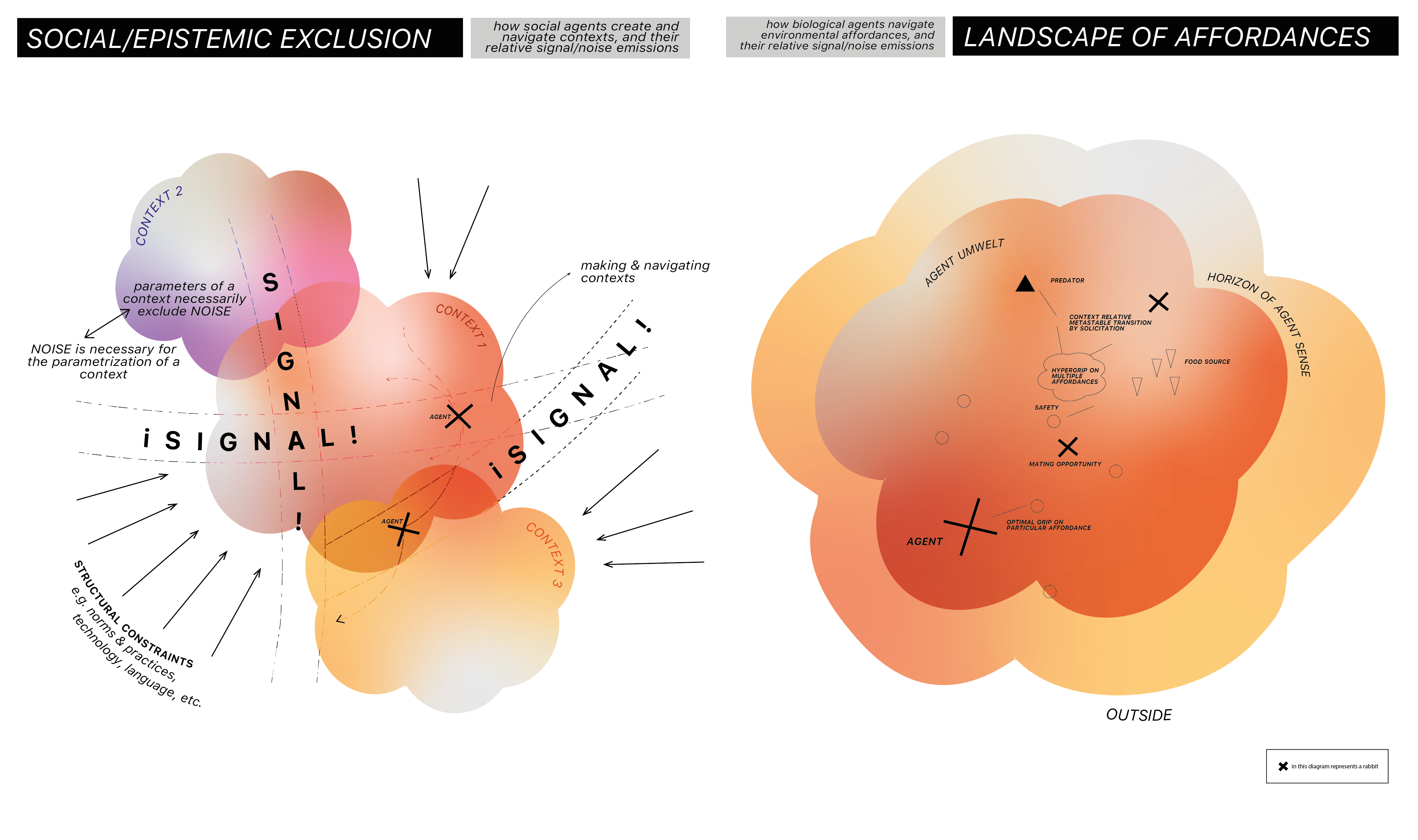
SOCIAL AND EPISTEMIC EXCLUSION
In this diagram (a 2D rendition of what might better be visualised with 3 or more dimensions) we see an overlapping and crossing of different contexts where “signals” are emitted/received. Signal is here understood as some salient information in relation to the presence of a social agent which recognizes itself as identified/ identifiable according to stable or shifting parameters (i.e. gender, belonging to different communities, etc.). What appears as a signal to a group of agents may be noise to a different group, which for example does not hold the same beliefs or expectations. Social and epistemic contexts are multi-layered, ever-multiplying, and increasing or decreasing in complexity. “Signals/noises” travel through contexts, get pushed or push themselves inside or outside of them, or overlap between two (or more) of them. All cognition and perception of signals is contextually framed–there is not a space or environment which is not-context for an agent. Contexts are constructed and shaped by structural constraints (e.g. technologies, beliefs, languages, communities, institutions, etc.). Particular agents might be excluded or alienated from certain socially defined contexts, for example as a woman in patriarchy or a D/deaf person in hearing culture. A social agent is capable of navigating contexts but also of engendering or transforming them. An agent can be expelled from a context when perceived as a disturbance, but can sometimes also opt out of a specific context.
LANDSCAPE OF AFFORDANCES
The Landscape of Affordances diagram broadens the scope of the social-epistemic exclusion diagram to account for cognitive processes in general rather than just social agents. It follows philosophers such as Bruineberg, Kiverstein and Rietveld in bringing together a number of different theories for an explanation of context-sensitive intentionality, in particular: Gibson’s theory of affordances, Merleu-Ponty’s theory of optimal grip, and contemporary work in cognitive science called predictive processing theory, which centrally involves an information theoretic measure of surprisal underlain by Friston’s free energy principle. Gibson’s theory of affordances explicitly rejects the standard cognitivist view that perception is a rule-governed internal computational representation of passively received external stimulus material, or that it depends on processing or enriching information, and replaces it with the idea that the dynamical coupling or reciprocity between organism-environment and action-perception allows for the extraction of invariant properties that have both objective world-oriented content and subject-oriented meaning. That is, there is a direct pickup of environmental information, which is strongly distinguished from the sender-receiver model of Shannon information. In contrast with classical computational theories of mind, which construe perception as the mental structuring of unstructured stimulus information, affordances are the possibilities for action given by the structured information, or statistical regularities, in the relation between an organism and its environment. These reliable correlations are supposedly perceived directly, i.e. without mediation by inference or representation. ‘An affordance...points two ways, to the environment and to the observer. So does the information to specify an affordance.’ The affordances of an object or event are just those aspects which have adaptive significance for the survival of the organism. Gibson defines a niche as ‘a set of affordances’. Affordances become available to an organism through a process of ‘attunement’ or resonance with its niche. For Gibson, we do not perceive information as such (i.e. as neutral segments of qualitative material whose identity or meaning we then infer) but meaningful affordance structures, or opportunities for action, and these may either be structural invariants (persistent features) or transformational invariants (changing features). For example, the timbre of a trombone may be viewed as a structural invariant over a melody, and the sliding change of pitch as a transformational invariant within it. Structural and transformational invariants are intrinsically topological: both are structure preserving transformations describing morphological continuities and discontinuities. But these structural and transformational invariants, and the relations between them, are also beset by noise and ambiguity, particularly when they involve interactions with other agents and at the social level. The invariant figure is always grasped against a ground of variance and noise, regularities are never free from irregularities (indeed both are phenomena that depend on syntheses at a certain spatial or temporal scale), identity is underlain by difference, and identification is plagued by ambiguity. Despite Gibson’s few comments on the matter, disattunement is then pervasive. Though the emergent macrostructure of the external environment is a rich source of pheno-physical invariants, and the patterned regularities within it display a high degree of reliable causal covariance, it is also teeming with variance, aberrance, and duplicity. The external world is not in itself coherent. Structured information must be extracted from noise, a process that is highly fallible. When a particular stimulus material is ambiguous or when the affordance that an agent is seeking is obscured (e.g. by fog or noise), this induces perception to hunt for significance elsewhere. This may involve movements such as eye saccades or cupping the ear, or actions such as turning the object round, and may promote further calibration of sensory sensitivity. Rietveld and Kiverstein propose the concept of an affordance landscape in order to account for the way in which the sensory environment of an organism offers a range of action potentials that compete for perceptual attention. As the perceptual ecology of humans is a built environment, replete with artefacts and structured by norms, they argue it is necessary to expound more clearly how ecological theory could be applied to the cultural domain, where this had only been indicated in Gibson’s remarks concerning the extension of affordances to the ‘whole spectrum of social significance’. They maintain that affordances are not just possibilities for action but have a certain ‘demand character’: they are invitations that solicit behaviour. For example, when you are thirsty a glass of water solicits drinking, and when the DJ lays down a killer track it solicits synchronised movement. Rietveld and Kiverstein can then claim that solicitations are relative to a particular individual at a certain time, while affordances are relative only to the form of life, or econiche, in which they are objectively embedded. Importantly, they argue that the rich landscape of ecological information includes many irrelevant affordances, and that solicitation explains how an organism is responsive to the relevant affordance amongst the noise. Bruineberg and Rietveld bolster this claim by drawing on Merleau-Ponty’s notion of tendency towards optimal grip. Dreyfus defines optimal grip like so: ‘when one’s situation deviates from some optimal body-environment relationship, one’s motion takes one closer to that optimum and thereby relieves the “tension” of the deviation. One does not need a goal or intention to act. One’s body is simply solicited by the situation to get into equilibrium with it’. Bruineberg and Rietveld firstly understand optimal grip in terms of gradient reduction in self-organising systems, they then bring this explanation together with Friston’s free energy principle, which provides a generalised framework supposedly universally applicable to all things exhibiting a non-equilibrium steady state (brains, organisms, cells, salt, etc.), where their capacity to maintain that state against random fluctuations or to resist entropy over some non-trivial duration ‘can be expressed in terms of a gradient descent on (i.e. a reduction) of surprisal’. The way in which an affordance solicits attention is context relative, but an organism must be able to dynamically shift attention and alter behaviour in response to changes in its environment, and it is this context-sensitive selective openness to relevant affordances which Bruineberg and Rietveld call skilled intentionality. This is explained within the free energy framework, where free energy is defined as a measure of disattunement, and the tendency toward optimal grip as the surprisal minimising attunement of internal and external dynamics. Since the minimization of uncertainty must be responsive not only to changing external dynamics but also to changes in salience relative to shifting contexts, the brain and the whole brain-body- environment system display metastable attractor dynamics that are both robust to perturbations and flexible, so there is structural stability and fluidity within and across different perception-action cycles and behavioural routines. This optimal metastability explains the tendency of an organism to maintain itself poised at the edge of instability between various attractor states, which corresponds to the capacity to selectively track and switch between multiple relevant affordances simultaneously. Bruineberg and Rietveld suggest that the resulting ‘hypergrip’ avoids the frame problem because contexts may themselves be viewed as affordances.
The explanation of the landscape of affordances is excerpted from:
Wilkins, I. (2022) Irreversible Noise. Urbanomic
References:
Rietveld, E. & Kiverstein, J. (2014) A Rich Landscape of Affordances, Ecological Psychology, 26:4, 325-352 Bruineberg, J. & Rietveld E. (2014) Self-organization, free energy minimization, and optimal grip on a field of affordances. Frontiers in Human Neuroscience. Vol. 8 Gibson, J.J. (1966). The Senses considered as Perceptual Systems. London: Unwin Bros. Gibson, J. J. (1979/2015). The Ecological Approach to Visual Perception. New York, NY: Psychology Press. Merleau-Ponty, M. (1945) Phenomenology of Perception. Friston, K., Kilner, J., & Harrison, L. (2006). A free energy principle for the brain. Journal of Physiology, Paris. , 100 (1–3), 70–87. Friston, K. (2012). A free energy principle for biological systems. Entropy, 14, 2100-2121; doi:10.3390/ e14112100 Gibson, J. J. (1979/2015). The Ecological Approach to Visual Perception. New York, NY: Psychology Press. 132 Dreyfus, H.L. (2002) Intelligence without representation – Merleau-Ponty’s critique of mental representa- tion. The relevance of phenomenology to scientific explanation. Raja, V. & Valluri, D. & Baggs, E. & Chemero, A. & Aderson, M. (2021) The Markov Blanket Trick: On the Scope of the Free Energy Principle and Active Inference. Physics of Life Reviews.
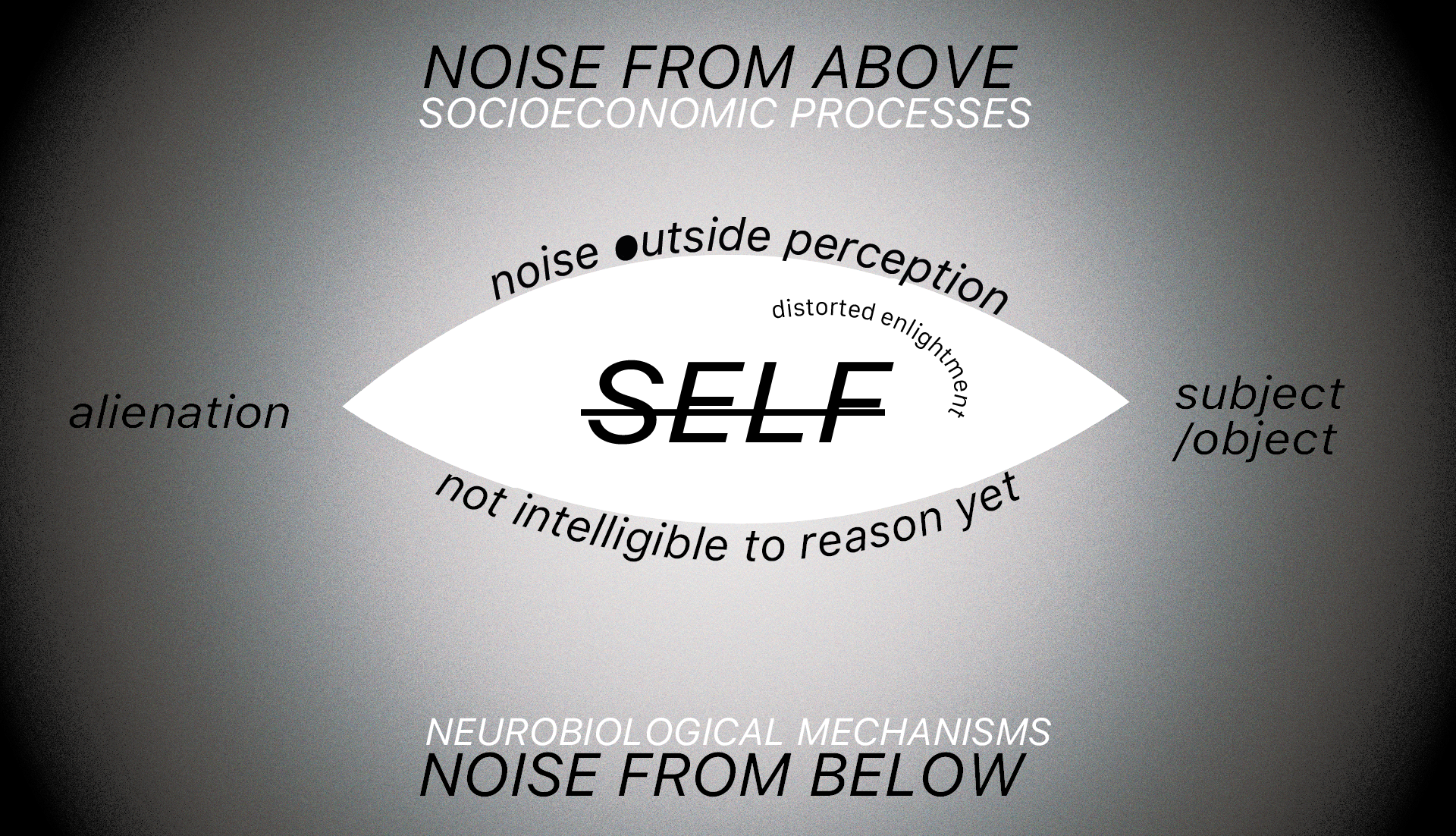
The way that value is produced under capitalist relations generates such a level of complexity that we can call it noise from above, a form of ignorance or opacity based on suprapersonal processes. We engage in socioeconomic processes that we don’t have the ability to fully comprehend nor to access from an empirical perspective. These processes condition and mediate how we understand ourselves and the subject/object relationship generating a limited and distorted perception which is historically constructed. After the dark ages and with the enlightenment’s secularisation, a new conception of the subject-object dualism led to a new exercise of power. In its wake new forms of oppression emerged. The Western distinction between conscious subjects and individuals treated as objects is indisociable from an understanding of reason premised on mastery of the subject over the object. From a post-enlightenment perspective, this paradigm of rational mastery does not take into account the way noise shapes our cognitive abilities and our perception of reality. The illusion of rational mastery is what we call distorted enlightenment. There is a ‘special form of darkness’ outside perception, connected to the way selfhood is produced. Recent developments in cognitive science are beginning to understand the self as an illusion, a simulated self-model generated in our brain in order to reduce neurocomputational cost. Ordinary experience only dimly discloses the subpersonal neurocomputational processes that support this simulation. This is what we call noise from below. Personal experience is engulfed in both of these forms of darkness: the subject is an impersonal vector of this supra-personal and sub-personal ignorance.

This diagram attempts to depict the changing use and meaning of sonic noise in music across its historical development. It first of all acknowledges that there are diverse perspectives on this development depending on the understanding of musical culture that one has. The perspective that is depicted is effectively a Eurocentric one, and this is expressively alluded to by the shape of the diagram, which looks a bit like a Peters projection global map. It is a graph where the horizontal axis is time and the vertical axis refers to the conception and practical elaboration of what music and sonic noise means, or what it can do. From the Western hegemonic perspective that it takes there is a central European idea of music surrounded by various local traditions of musicking. From its inception to the late nineteenth century this is dominated by the organisation of pure tones according to time and key signatures and the effective exclusion or non-musicality of noise. Other musicking traditions do not necessarily exclude noise (this includes various folk traditions in Europe). At the turn of Western modernity there is a transformation of the idea of music resulting both from internal change (rise of bourgeois power, urban populations, alienation, and then the development of audio technologies) and from transcultural encounters with other local traditions of musicking (e.g. jazz, blues). The distinction between high and low musical forms becomes more pronounced, and there is a use of sonic noise in both. The idea of music expands but is still relatively circumscribed and beholden to the dominance of Western power and its inherited conception of musicality. As globalisation advances this idea of music continues to expand, again through transcultural encounters, audio technologies and changing social conditions. Postmodernity is characterised by a milieu of tolerant multiculturalism in which a diversity of musical traditions coexist or are brought into a zone of exchange and fusion, but it remains anchored to the inherited dominance of the Western mode. The modernist distinction between high and low music is to some degree overcome but there is a pervasive commodification of musicking and a loss of the impetus of formal innovation. Noise becomes an accepted aspect of musicality. On the one hand it is domesticated and loses the intrinsic critical power that drove its modern expression, on the other hand its use in a variety of avant garde and popular forms continues to enact social and musical transformations. We characterise the current development of that expansionary process as a move to transmodernity which has the power to unmoor itself from the Western hegemonic perspective of musicality, to galvanise formal innovation, and to catalyse critical uses of noise that further transform the idea of music and its current social conditions.
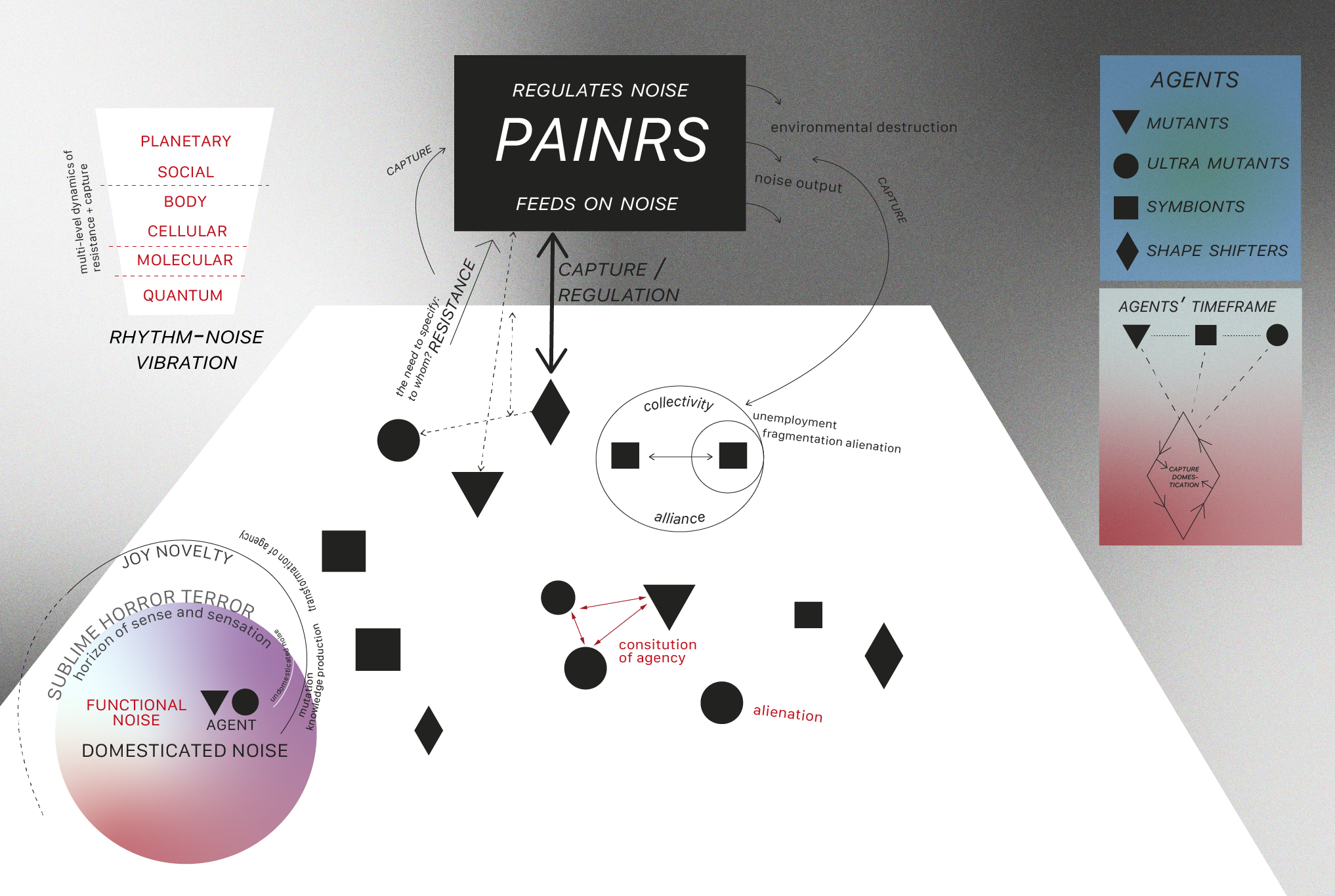
Determining the specificity of noise in the 21st century requires laying out the historical processes that led up to it. What noise means was dramatically changed in the 20th century, not only with the development of computer science, information theory and cybernetics, but also in terms of the political and aesthetic upheavals occurring then. Information and computation technologies transformed and accelerated an already existing statistical form of social control which can be traced back to the onset of colonialism and capitalism several centuries before. Those 20th century technologies were based on the construction of systems that were robust to noise, i.e. that minimised or eliminated noise, and they accompanied or enacted an exclusionary form of power that regulated deviance from its normative framework or disciplined interference from its goals. Within this paradigm the generation of noise was a critical act, which can be seen in many different artistic practices, countercultures and political movements. Towards the latter part of the twentieth century there was a shift both in the form of power and its technical realisation. This shift can be characterised as one that moves from centralised control systems that are robust to noise towards decentralised control systems that are resilient to noise. Noise is no longer external to the control system but has become core to its operations. Rather than policing difference and noise they encourage it, they feed on it and smoothly regulate it. The distinctive features of this new neoliberal control system include: the financialization of all aspects of economic life, the collapse of centralised broadcast media into massively distributed information and communication networks (social media, user generated content, fake news, etc.) the development of machine learning (which departs from the classical form of early 20th century computing and enables a dynamic regime of constantly revised Bayesian probabilistic inductions on complex and qualitative data sets), and the pervasive application of these predictive AI tools to all aspects of social life in a massive program of surveillance and continuous flexible control. This diagram attempts to show the dynamics of agency and revolt under these new political conditions, which are dominated by what we call PAINRS: Predictive Artificially Intelligent Noise Resilient Systems. Google and Meta are of course PAINRS, but so are any relatively wealthy or technologically enabled states, corporations and institutions. Agents are depicted according to the types of interaction and transformation they are undergoing, a key is shown at the top right. At the top left the multilevel dynamics of resistance, capture and transformation are shown, each of which emer- ge from or rely on the vibrational continuum between rhythm and noise. An agent is called a mutant if it is transforming its own conditions, this may be through expanding its horizons of sense and sensibility or engaging in new behaviours. Mutations may be the result or cause of noise relative to its internal or external milieu. Alliances between agents can give rise to symbionts. An agent whose transformative power is prodigious is called an ultra-mutant. It is highly noisy. Finally there are agents which we call shapeshifters because though they have the outward appearance of change they are complicit in the continued maintenance of the current horizons of sense and sensibility and the accompanying form of social power. PAINRS capture and feed on the noise produced by these agents, even or especially when that noise is critical of the system of power that the PAINRS preside over. Though noise is no longer intrinsically critical under this paradigm there are still important critical uses of noise. Though most resistance is captured, resistance is not futile. There is no way back from PAINRS but that doesn’t mean there is no way forward. Mutants, symbionts, and ultramutants could completely transform their own conditions of agency.
These diagrams are the result of a 2-day workshop facilitated by NRU at SOOPA, Porto (PT) in December 2021. This event was partly supported by v2_ Rotterdam (special thanks to Boris Debackere). They are the outcome of collective discussions around noise in its different interpretations/manifestations, and the illustrations as well as their accompanying descriptions include the work in progress that NRU members are develop individually as well as collectively. This booklet has been produced to accompany the performative presentation of the diagrams by NRU at Cafe OTO on May 18th 2022.
Design of digital diagrams:
Diede van Ommen
Participants SOOPA, Porto, December 2021:
alex cruse Carlos Azeredo Mesquita Jonathan Uliel Saldanha Catarina Miranda Lendl Barcelos Luis Fernandes Sami Hammana & other more anonymous participants
The NRU diagrams are always collaborative creations of the workshop participants + NRU, and translated digitally by NRU + Diede van Ommen. Since its inception, NRU has been funded and supported by the NRU members, and depending on the event, also by: SOOPA, v2_ Rotterdam, Collège International de Philosophie, Bidston Observatory, Café OTO, Stimuleringsfonds, UNSOUND Festival, and more.
For any questions please contact us at: noiseresearchunion at protonmail dot com